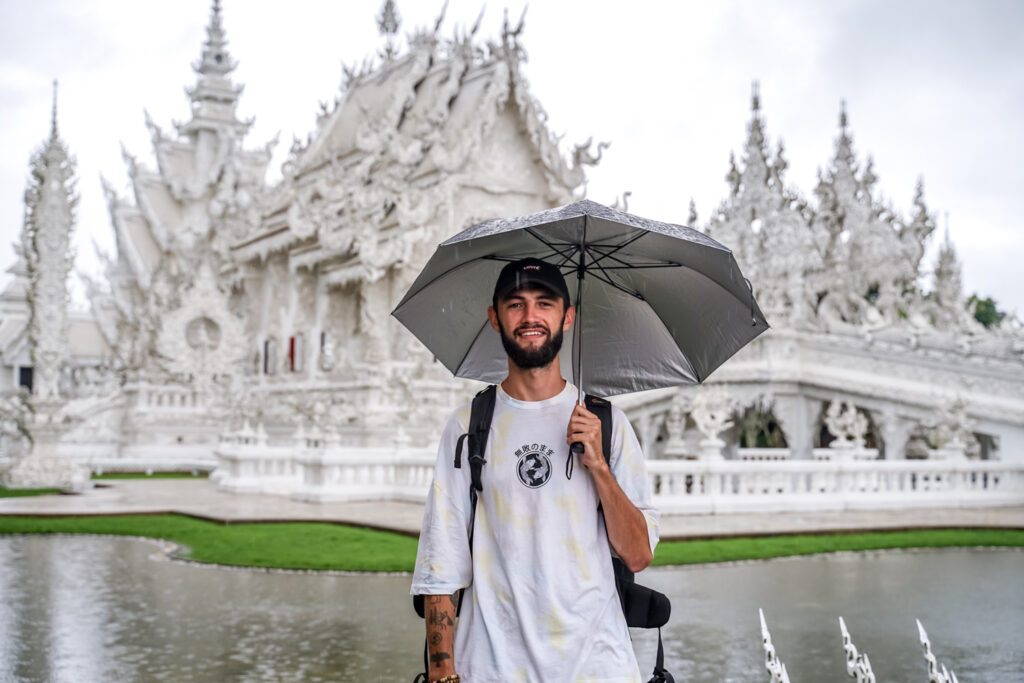Disclosure: This post contains affiliate links that I may earn a small commission from if you purchase something through them. This comes at no extra cost to you!
Southeast Asia is a backpacking hub known across the world for it’s affordable prices, abundance of attractions, accessibility, diversity and safety, making it one of the best regions in the world for independent travel.
Although I have visited all of the 11 countries in Southeast Asia (apart from East Timor… I’m coming for you one day!), I still make some silly mistakes when it comes to packing my bag for a big trip. With what I’ve learned about travelling and organising over the years, I’ve created this list of 34 essential items and tips that need to be on your packing list so you can keep the regrets (and weight) to a minimum throughout your trip!
Check out this post too for everything you need to know before you go to Southeast Asia: 46 Need-To-Know Travel Tips Before Backpacking Southeast Asia.
Let’s dive straight into some essentials.
Table of Contents...
Toggle
34 Packing Essentials
As the old saying goes; failing to prepare is preparing to fail!
1. Don't pack too much
First things first, and I have been guilty of this one too many times, but you never need as much as you think you’ll need. Even better, anything you do end up needing can be found for half the price as it would be at home too!
A good rule would be if you aren’t going to use an item at-least once a week, don’t pack it. For example, I packed a hoodie on my most recent trip to Thailand… do you think I’ve used it 3 months later? Nope.
Remember, you’re going to be carrying (or dragging) this bag a lot in the coming weeks or months, so you’ve got to think about weight too.
2. International adapter
You will need an international plug adapter when you travel – fact. I use MyTravlPal which is ideal.
Most of the best adapters are set up to work in every country in the world and have multiple USB sockets so you can charge more than one gadget at a time. They are lightweight and the type of one-time investment that you’ll use for many years – a real no-brainer!
3. Packing cubes
Packing cubes are an absolute game-changer. They help to save space in your backpack and organise everything into specific sections. There’s nothing worse than looking for a certain item and having to rake through your entire bag to find it!
This way you can have different cubes for T-shirts, underwear, waterproofs, or warm clothes – up to you. You could even label them to be super-duper organised!
These are the ones I use, but there are more budget friendly options here.
4. Portable power bank
This little piece of kit doesn’t take up much space and comes in handy all the time while travelling cross-country on long bus journeys and in rural areas.
With this, you’ll never need to worry about running out of battery on your phone and gadgets, with many chargers featuring multiple USB sockets and long battery life. The best ones can be quite heavy, but once fully charged you should get at least 2 full phone charges from it. With this you’ll always feel safe in the knowledge that you can charge your phone at any time and remain connected to maps and social media or make emergency phone calls.
There are thousands of options out there. View them here.
5. Travel towel
A microfibre travel towel is an essential for any backpacker in Southeast Asia, whether you’re planning to relax on tropical beaches, swim at waterfalls or go diving somewhere like Koh Tao in Thailand.
They take up a surprisingly small amount of space when compressed into a small sleeve which is perfect for stuffing into your bag. I take mine all over the world with me. They are fast-drying much more convenient for packing than a standard towel.
Check out the best travel towels here and the one I use below.
6. Padlock
Maybe an obvious item, a padlock is a cheap and useful thing to have so you can safely leave your bag somewhere and not be constantly worrying about theft.
Every time I leave my room, get on a plane or take a public bus I will lock my bag. The way I see it is there’s no reason not to! It can be especially ideal if you’re staying in large dorms with lots of people you don’t know – just make sure you don’t forget the combination to it!
7. Starling travel card
“The no-fees travel bank card” will save you money and hassle – a valuable asset while on the road.
I’ve been using a Starling Card for the past few years and with one of these the only fees you’ll need to pay are the standard ATM fees – you’ll never be charged for spending your money internationally.
With its super user friendly app, in my opinion no travel card comes close to this one. It’s also completely free to start using!
8. USD currency
The US Dollar is a recognised currency worldwide and it’s a good idea to always have some tucked away, just in case.
Times when you might wish you had some back-up currency are when paying for visas on arrival (which often required USD) or when ATM’s refuse to dispense money at a time of need. You can exchange USD for local currency in every country, just make sure to check current rates so you don’t lose money with a terrible one!
9. Travel journal
These are a great way to keep track of your movements and thoughts while on the road in Southeast Asia.
In the less-developed Southeast Asian countries card payments are not common and cash is predominantly used. By noting down what cash leaves your wallet, and for what, you’ll also be organised and aware of how much you spend!
10. Water bottle
I always have a water bottle with me because it’s extremely important to stay hydrated in these super hot climates. The tap water is totally undrinkable in Asia for us weak-stomached foreigners, so using a bottle with a built-in filter is an even better idea so you can drink it freely.
However, there are often safe drinking water taps available in hostels and some public spaces to allow to you to refill for free and cut down on buying plastic bottles every time you’re thirsty!
It not only saves the planet by using
cutting down on waste, but also saves you around $0.50 – $1 every time you’d normally buy a bottle!
11. Water purification tablets
On that note, unless using water purification tablets tap water will more than likely make you sick in most countries. Best take these just in case.
12. A good travel camera
It always surprises me how many people don’t visually document their travels.
For me, this is the number one essential because I simply couldn’t travel without a camera! There are many lightweight, compact, high-quality travel cameras available that take much nicer photos than your phone – even with technology of phones today!
I use the Sony A7ii which, for me, is absolutely perfect and very versatile albeit maybe a bit fancy for your average traveller. Check out these compact cameras on Amazon or the ultimate adventure camera, a GoPro, below.
13. A travel wallet
I always have a travel wallet with me to store certain essentials.
Use it for things like keeping your passport safe when you don’t need it, storing various currencies from previous countries (I collect money from everywhere I’ve been as a souvenir), passport photos for any required visas, emergency USD and a pen or pencil.
14. Copies of important documents
15. Dry pack
A dry pack is an absolute essential for outdoor activities like kayaking, island-hopping, trekking, beach visits or anything where there’s a risk of water damage.
They are totally waterproof and feature a roll-over locking system so they can be completely submerged and your stuff will stay dry (although I don’t recommend purposely doing that!). I bought one of these while travelling around the islands in the Philippines and it saved my gadgets more than once!
You’ll see a lot of these on the islands!
16. Flip-flops or sandals
An obvious essential for beach days and hot weather, flip flops or sliders are actually a very good thing to have for hostels and guesthouses too. Hear me out!
Many bathrooms in southeast Asia are wet rooms, meaning when you shower the entire room gets soaked. So, instead of going to the toilet and having to walk through water, having a pair of sliders (my personal preference) just makes sense. You can find lots of cheap flip flops or sliders everywhere in Southeast Asia but if you wanna be uber prepared then have a look at the options here.
17. First-aid kit
While travelling, unfortunately things can go wrong at any given moment, especially in less developed countries where road conditions are poor, food poisoning is common and health and safety is less enforced.
It’s vital to have a small bag of basic first aid items, for example:
- Plasters
- Bandages
- Paracetamol
- Imodium in case you get a violent case of “Bali belly”
- Hayfever tablets if you suffer like me
- Hand sanitiser
18. Poncho or light rain jacket
Essential if travelling in Asia in the monsoon season, it pays to buy a half-decent poncho to stay as dry as possible during a downpour.
You can find cheap plastic ones in most supermarkets like 7/11, which do the job in emergencies but tend to rip quite easily and only survive a couple of storms. Pack a lightweight rain jacket or go on a bargain-hunt for a reusable poncho once you arrive at your destination.
19. Bug spray
In the tropical climates of Southeast Asia it’s always handy to have some mosquito repellent so you don’t get eaten alive (but you probably will anyway!).
If you plan on doing any hiking in humid forests or spending time near stagnant water, best pack some decent bug spray.
20. Earplugs
Extremely handy in hostel dorms and overnight buses, earplugs take up zero space and are cost effective, so stock up if you are a light sleeper. After all, nobody enjoys trying to fall asleep when the guy above you sounds like he’s having an exorcism.
21. External hard drive
If travelling with a camera, an external hard drive is perfect to back-up the thousands of photos and videos you’ll be taking. I usually try to do a weekly back-up of everything.
I have a LaCie 4TB hard drive which has ample storage space, but I’ve have some connectivity issues with LaCie’s products in the past so I also have a 1TB Seagate One Touch which seems more reliable.
Here are the two I use on Amazon.
22. Shoes (if you have big feet!)
I hate to disappoint, but if your shoe size is bigger than UK 12-13 you will not be able to buy cheap shoes in Southeast Asia.
It’s pretty gutting because there are some real bargains in this part of the world, but I’m 6ft 3” and I have learned in the past that if I go looking for a bargain pair of shoes here, the shopkeepers will just point and laugh at my feet!
Best to pack one or two durable pairs from home instead.
23. Sunglasses, hat & suncream
These three kind of go without saying, but nevertheless, it’s important to stay protected in the heat of the day.
These are the type of international items you can pick up for a few dollars anywhere in the world, so no need to bring any designer shades with you!
24. Portable speaker
For any music lovers like me, a portable speaker is such a good tool to have. The quality is better than just blasting songs out from your phone and it can be a great way to get warmed up for a night out with friends or when chilling on a beach.
There are many lightweight speaker options but my personal favourite company is JBL – they’re products are sick!
25. Multi-tool
A multi tool could come in handy on many occasions, especially one with a bottle opener on it!
It’s something that is small, lightweight and one of those “you never know” essential items.
26. Tiger balm
The cure to everything!
Tiger balm is a great addition to your backpack and something I use all the time. It is a heat rub mainly used for soothing aches and pains, but I use it on just about anything. It heals spots, bug bites and scratches overnight, and it also works for clearing a blocked nose.
27. A bum-bag/money belt
Prepare to go full tourist!
Very popular for walking around busy streets when you want to keep your money safe but don’t want the hassle of carrying around a rucksack or handbag.
Personally I don’t use one because it makes you stand out even more than normal, and I don’t need that. However they are extremely popular over here and would be the perfect handbag equivalent for cash and small items.
28. Cards/small games
Having a deck of cards at the ready can be a real ice-breaker and a great way to socialise. All small, lightweight games like this are a great item to chuck in your bag as long as you’re likely to use at-least a few times on your trip. Have a look through all these great options.
Just don’t be that one guy who takes it all too seriously!
29. Earphones
Earphones are great for those times you just want to zone out.
I listen to music and podcasts all the time and they’re an absolute essential for long flights or overland journeys. They can also be used as an earplug alternative!
30. Neck pillow
Again, coming in to play on long bus, train, car or plane journeys, a neck pillow can be compressed to nothing so takes up no space in your bag when not in use.
This admittedly isn’t something I use because I can’t sleep sitting upright anyway!
31. Travel Apps
There are an array of useful Apps out there for backpackers, aside from the standard accommodation booking ones like Hostelworld or Booking.com.
Download some before you arrive so you’re familiar with them and prepared. Simply by having Grab or Xe Currency by the time you land will save you money and allow you to avoid being potentially scammed or overcharged by a taxi.
Some great Apps are:
- Xe Currency – Real-time exchange rates that automatically update every 60 seconds.
- Google Translate – Helps to solve the language barrier problem with local people. It also has a function where you can take a photo of any foreign text and it’ll translate it – a proper game changer.
- Maps.me – Many people use Google Maps, but I find Maps.me far more suitable. Download maps to use offline, plan a route and pin destinations for later.
- Grab – Asia’s version of Uber is available in most cities and major towns and offers affordable rides that can be paid for on card and are tracked, so it’s safe too.
- TripAdvisor – Check out reviews of restaurants and sights before you go to see what sort of experience others have had recently.
- Hinge/Bumble/Tinder – Mostly used as dating apps but don’t rule these out because these are also a great way to make friends with like-minded people and share experiences.
32. Learn some local language
Okay, so it’s not something you physically put in your bag, but it is something you can take with you!
Locals absolutely love to see you try and speak their language, even if it’s just the most basic phrases. “Hello” and “thank you” are obvious pleasantries to know, but why not push the boat out and learn something like “can I have an iced coffee, please” and I promise you’ll get a good reaction. You often see people’s faces light up when you just give it a go!
33. Lonely Planet guidebooks
The Lonely Planet guides are a brilliant source of information, and they have guides for just about everywhere in Asia!
They have expect advice and recommendations on so many countries!
Check out these popular ones:
34. Local SIM cards
A true travel essential that you should get on arrival anywhere you go for a decent amount of time.
Stay connected across the world with friends and family by buying a local SIM card. I get one in every country I visit because they are extremely affordable and have high 4G speeds.
Prices vary across the continent, but you can expect to pay anything from $2-$12 for unlimited data for 30 days. They can be topped up all over the place at stalls and supermarkets, so if you run out of data it’s never the end of the world!
Note: SIM cards at airports or guesthouses are a lot more expensive than in street stalls or supermarkets, so unless you’re desperate, it’s best to wait until you’re in the center of town to buy one.
Read next:

Thank you for reading this travel guide – I hope you found it helpful! Feel free to leave a comment below if you have any questions and I’ll get back to you as soon as possible
Happy travelling!
HELPFUL RESOURCES FOR PLANNING YOUR TRIP
Accommodation: Booking.com, Hostelworld
Tours: GetYourGuide, Viator, Klook, TripAdvisor
Transport: 12Go, Omio, Trip.com, Rome2Rio
WHO IN THE WORLD IS JAMES?
Click below to learn more about my story, including 5 random facts about me, some travel FAQ’s and my entire travel history.


